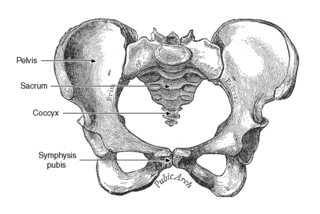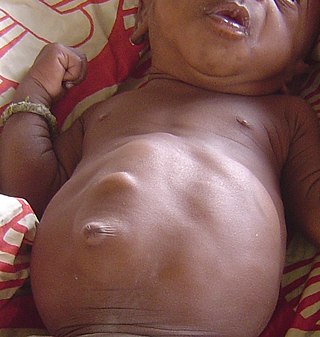
Pelvic lift (also known as pelvic tilt) is an exercise to strengthen the lower back, [1] glute muscles, lower abdominal muscles, and maintain hip muscle balance. It does not require weights, although they can be placed on the stomach. [2]

Pelvic lift (also known as pelvic tilt) is an exercise to strengthen the lower back, [1] glute muscles, lower abdominal muscles, and maintain hip muscle balance. It does not require weights, although they can be placed on the stomach. [2]
There are four steps in the exercise. [3]
The pelvic floor is a "broad sling of muscles, ligaments and sheet-like tissues that stretch from your pubic bone at the front of your body, to the base of your spine at the back". [4]
The pelvic floor is resistant to stretch and weight as it bounces back. However, after carrying weight for long periods of time, it can become stretched. [4] Additionally, weight on the pelvic floor can weaken its resistance and contribute to its loss of shape over time. [4]
Performing this exercise routinely can strengthen glutes, abs, and lower back muscles. As a result, doctors may recommend pelvic lifts to reduce lower back pain, improve posture, and improve bladder control. [5]

The human leg is the entire lower limb of the human body, including the foot, thigh or sometimes even the hip or buttock region. The major bones of the leg are the femur, tibia, and adjacent fibula. The thigh is between the hip and knee, while the calf (rear) and shin (front) are between the knee and foot.

Calisthenics or callisthenics (/ˌkælɪsˈθɛnɪks/) is a form of strength training consisting of a variety of movements that exercise large muscle groups, such as standing, grasping, pushing, etc.

Kegel exercise, also known as pelvic floor exercise, involves repeatedly contracting and relaxing the muscles that form part of the pelvic floor, now sometimes colloquially referred to as the "Kegel muscles". The exercise can be performed many times a day, for several minutes at a time but takes one to three months to begin to have an effect.

The bench press, or chest press, is a weight training exercise where a person presses a weight upwards while lying horizontally on a weight training bench. Although the bench press is a full-body exercise, the muscles primarily used are the pectoralis major, the anterior deltoids, and the triceps, among other stabilizing muscles. A barbell is generally used to hold the weight, but a pair of dumbbells can also be used.

Lordosis is historically defined as an abnormal inward curvature of the lumbar spine. However, the terms lordosis and lordotic are also used to refer to the normal inward curvature of the lumbar and cervical regions of the human spine. Similarly, kyphosis historically refers to abnormal convex curvature of the spine. The normal outward (convex) curvature in the thoracic and sacral regions is also termed kyphosis or kyphotic. The term comes from the Greek lordōsis, from lordos.

A squat is a strength exercise in which the trainee lowers their hips from a standing position and then stands back up. During the descent, the hip and knee joints flex while the ankle joint dorsiflexes; conversely the hip and knee joints extend and the ankle joint plantarflexes when standing up. Squats also help the hip muscles.
The good-morning is a weight training exercise. It is known as a good morning because of the movement in the erector spinae which resembles the bow that traditionally begins a schoolday in some East-Asian countries. The erector spinae muscles of the lower back work isometrically to keep the spine in an extended position while the hamstrings and gluteus maximus work isotonically to perform hip extension. Other muscles are involved in stabilizing weight on the back and maintaining balance.
Abdominal exercises are a type of strength exercise that affect the abdominal muscles. Human abdominal consist of four muscles which are the rectus abdomens, internal oblique, external oblique, and transversus abdominis. When performing abdominal exercises it is important to understand the effects, functions, the types of exercises, and think about how to perform this exercise safely.
General fitness training works towards broad goals of overall health and well-being, rather than narrow goals of sport competition, larger muscles or concerns over appearance. A regular moderate workout regimen and healthy diet can improve general appearance markers of good health such as muscle tone, healthy skin, hair and nails, while preventing age or lifestyle-related reductions in health and the series of heart and organ failures that accompany inactivity and poor diet.

The acetabular labrum is a fibrocartilaginous ring which surrounds the circumference of the acetabulum of the hip, deepening the acetabulum. The labrum is attached onto the bony rim and transverse acetabular ligament. It is triangular in cross-section.

Symphysis pubis dysfunction (SPD), commonly known as pubic symphysis dysfunction or lightning crotch, is a condition that causes excessive movement of the pubic symphysis, either anterior or lateral, as well as associated pain, possibly because of a misalignment of the pelvis. Most commonly associated with pregnancy and childbirth, it is diagnosed in approximately 1 in 300 pregnancies, although some estimates of incidence are as high as 1 in 50.

Diastasis recti, or rectus abdominis diastasis, is defined as a gap of about 2.7 cm or greater between the two sides of the rectus abdominis muscle. The distance between the right and left rectus abdominis muscles is created by the stretching of the linea alba, a connective collagen sheath created by the aponeurosis insertions of the transverse abdominis, internal oblique, and external oblique. This condition has no associated morbidity or mortality. Physical therapy is often required to repair this separation and surgery is an option for more severe cases. Standard exercise rarely results in complete healing of the separated muscles.
Neurogenic claudication (NC), also known as pseudoclaudication, is the most common symptom of lumbar spinal stenosis (LSS) and describes intermittent leg pain from impingement of the nerves emanating from the spinal cord. Neurogenic means that the problem originates within the nervous system. Claudication, from the Latin word for to limp, refers to painful cramping or weakness in the legs. NC should therefore be distinguished from vascular claudication, which stems from a circulatory problem rather than a neural one.
In kinesiology, core stability is a person's ability to stabilize their core. Stability, in this context, should be considered as an ability to control the position and movement of the core. Thus, if a person has greater core stability, they have a greater level of control over the position and movement of this area of their body. The body's core is frequently involved in aiding other movements of the body, such as running; thus it is known that improving core stability also improves a person's ability to perform these other movements.

A back extension is an exercise that works the lower back as well as the mid and upper back, specifically the Erector spinae. Each of us have two Erector spinae muscles, one of either side of the spine that run along the entire length of the spine. Erector spinae muscles are actually formed of three smaller muscles – spinalis, longissimus, and iliocostalis.

The leg raise is a strength training exercise which targets the iliopsoas. Because the abdominal muscles are used isometrically to stabilize the body during the motion, leg raises are also often used to strengthen the rectus abdominis muscle and the internal and external oblique muscles.

The Precor USA StretchTrainer is a piece of exercise equipment used to improve flexibility, coordination and athletic performance. The seated design ensures that users are kept in the correct position to stretch muscle groups.

The pelvis is the lower part of the trunk, between the abdomen and the thighs, together with its embedded skeleton.
Williams flexion exercises (WFE) – also called Williams lumbar flexion exercises – are a set or system of related physical exercises intended to enhance lumbar flexion, avoid lumbar extension, and strengthen the abdominal and gluteal musculature in an effort to manage low back pain non-surgically. The system was first devised in 1937 by Dallas orthopedic surgeon Dr. Paul C. Williams.